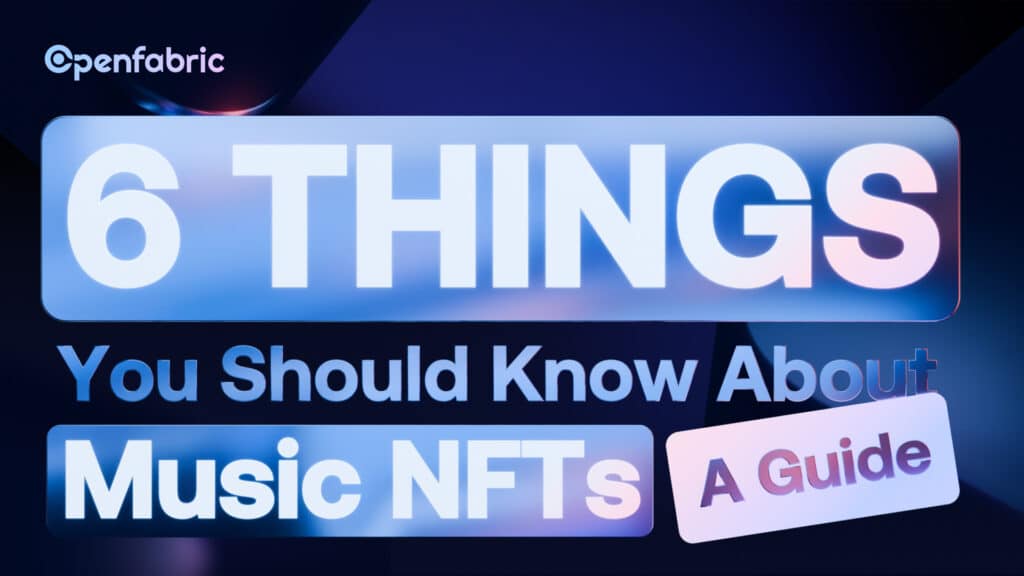
September 20, 2024 7 minutes read
6 Things You Should Know About Music NFTs: A Guide

Music is as old as humanity itself. From time immemorial, humans have created beats, melodies and rhythms that are pleasing to the ears. But as the years roll by, music changes. Another revolution is about to come in the music industry and it is not just limited to the beats. NFTs or Non-Fungible Tokens have recently been trending in the art and collectibles market. However, their influence is yet to spread in the music industry as music NFTs.
Music NFTs are changing how artists produce, distribute, and sell their music. The first music-related NFT event occured in 2014 with a virtual festival. For this festival, attendees could purchase tickets using Bitcoin. These tickets were in turn stored as NFTs on the blockchain.
Fast forward to 2021, the industry witnessed the first use of NFTs by Justin Blau, better known by his stage name 3LAU. He made $11.7 million from selling his “Ultraviolet” collection of 33 distinct NFTs in February 2021.
More recently, conventional music has begun to incorporate NFTs to promote their work and generate new income. For example, a lot of musicians and music enthusiasts like The Weeknd, Eminem and Steve Aoki have made millions of dollars leveraging music NFTs for their music. This shows that this concept is not a mere fad but it is a revolution in the concept of owning, listening, and even appreciating music.
In this article, we will explore what music NFTs are, and the advantages they hold for musicians and listeners. We will also explore the implications of blockchain, as well as tips on how to start with music NFTs.
This guide provides comprehensive information that will help you understand the vibrant and constantly developing world of music NFT. Let’s dive in.
What are Music NFTs?
Music NFTs are non-fungible tokens and represent the new ways of accessing and consuming music. They are a novel form of digital currency that creates value for the ownership of a certain item related to music. Such items can include but are not limited to;
- Exclusive tracks or remixes.
- Limited edition albums or EPs.
- Music videos or live performance recordings.
- Artwork, merchandise or collectibles.
- Live performances in the form of virtual concerts or virtual meets-and-greet.
- Concert tickets and other available merchandise.
All these digital assets are stored on a blockchain which makes them scarce, authentic, and of proven ownership.
Music NFTs are digital assets meaning it can be bought, sold, and even traded in the market. However, their usefulness and worth are based on their differences and the opportunities they provide.
The foundation upon which music NFTs are built rests squarely in traditional music. However, they differ from traditional music ownership in several key ways:
- Ownership: Music NFTs prove that a person owns an original file/asset. On the other hand, owning the music for traditional music may involve streaming or downloading of copies.
- Scarcity: As with other forms of Collectibles, these NFTs are also scarce, meaning that they may appreciate in value.
- Exclusivity: Music NFTs contain a part of uniqueness that provides value as well as better interactions between artists and their consumers.
Benefits of Music NFTs
As we have discussed, the application of NFTs in music has many advantages at both the creator and consumer levels. The benefits of Music NFTs are evident when it comes to the creation, consumption, and commercialization of music for the artists and the fans.
For the artist;
- Direct revenue streams: they allow artists to monetize their work directly without going through intermediaries as is the case with other industries like the music industry.
- Ownership and control: it gives artists the control over the ownership and management rights of their songs, paintings, and other forms of creativity.
- Increased fan engagement: the use of these NFTs enable artists to develop closer relationships with consumers and focus on building a dedicated fan base.
- Creative freedom: music NFTs are beneficial for artists because they allow them to choose non-traditional formats, styles, and even cooperation partners to work with.
For the fans;
- Exclusive experiences: The use of Music NFTs gives fans unique music consumption experiences. This may entail exclusive songs, versions, or concerts.
- Ownership and scarcity: It allows fans to own rare and valuable digital assets which have real prospects in terms of appreciation.
- Early access: It gives the fans a chance to listen to new tracks, albums or other forms of musical creativity before anyone else.
- Community building: Music NFTs foster interaction with other music enthusiasts in the same genre, which creates a sense of belonging.
Blockchain and Smart Contracts in Music NFTs
Blockchain technology involves the use of a shared and distributed database to file transactions and information. This record is stored in a decentralized manner, over the network of nodes, making it transparent, secure and tamper-proof. Application of smart contract as a self-executing contract is used in music NFTs to perform several tasks. They enable artists to create NFT music collections, change ownership, and pay royalties, thus simplifying the ownership process.
Smart contracts eliminate the need for middlemen, helping artists sell their material to their fans directly. Such a direct exchange between the performers and the public helps create a much closer relationship between both parties. Since rules and conditions are uploaded into smart contracts within music NFTs, artists are paid fairly for their work.
How does Music NFTs Utilize Blockchain
Music NFTs use blockchain technology to enhance the security of ownership and transfer. When an artist drops a music NFT, it gets deposited on a blockchain and is assigned a distinct identification number (cryptographic hash). This hash serves to ensure that no one can alter the NFT or make copies of it for owning them. The blockchain record of an NFT identifies the current owner. It also contains information about the ownership transfer, ensuring transparency and security.
This brings about a secure ownership framework which allows artists to own their content and engage their fans freely.
The use of blockchain technology also allows for the use of fractional ownership. This means that more than one user can own a fragment of an NFT related to music. It encourages new innovations that can be used to generate income and new investment opportunities.
Getting Started with Music NFTs: 6 Things You Need to Know
Music NFTs can be a goldmine if understood properly and leveraged. As it is finding a vast application in the music industry, it is necessary to know what to do if you are planning to invest in it. Here are six things you should know or do before delving into music NFTs.
Define your NFT strategy
To start with music NFT production, you must set goals and objectives, and identify the audience. This is part of your NFT strategy. Define which type of NFTs may be suitable for your brand and your artistic concept.
Think of rare, exclusive products that are not available at your competitors’ stores. It could be custom designs, or limited editions of products.
Understand blockchain technology
Understand the concepts of smart contracts, cryptographic hash, and a decentralized ledger system. This knowledge will enable you to have a clear understanding of music NFT generation and possession.
You can get a lot of resources that will help you to understand the concept of blockchain technology from our WEBSITE. Ensure to check them out today or prioritize it on your to-do list tomorrow.
Create your content, if need be
If you are not an investor but a creator, then you need to create the content to be used as an NFT. Create original content that will draw the interest of your target clients or fans.
Creating content is very easy on the Openfabric AI platform. By using our Soundfabric AI bot, you can create original content using only text prompts. This bot is basically a text to music AI tool. It has Natural Language Processing (NLP) which helps to translate the most basic imputed instructions to create an accurate music product.
Check out the Soundfabric AI bot on our website and follow the simple steps to get started.
Choose the right platform
Choose the right NFT marketplace or platform based on which one addresses your needs the most. Some of the platforms include OpenSea, Rarible and Audius. Be sure to inquire about research fees, commissions, as well as the terms of service of the service providers.
Build a community
Music NFTs are all about community involvement. Communicate with fans using social networks, Discord, and other means of communication. Furthermore, promote the provision of feedback, cooperation, and contribution.
Stay up-to-date with industry developments
The distribution of music NFTs is still largely growing. Continually update yourself on the emerging platforms, new technologies, and trends in the industry. Take part in online and live seminars, workshops, conferences to be part of informed communities and meet people who share common areas of interest.
Conclusion
Music NFTs revolutionizes the way music is sold and interacted with. The expansion of this music industry begs the need for professionals in the industry to be knowledgeable and adapt to the new changes. This will in turn create more opportunities for innovation and collaboration and provide additional revenue streams. This technology is one characterized by creativity, and technological innovation. Thus, we must accept the concept of music NFTs to open a new chapter of possibilities innovation and creativity.

